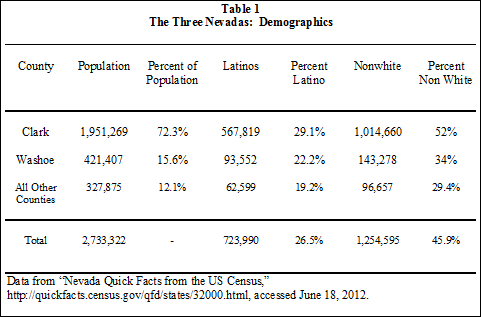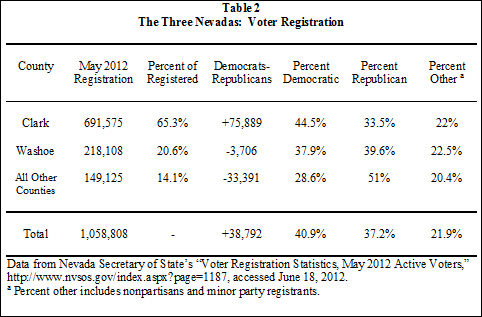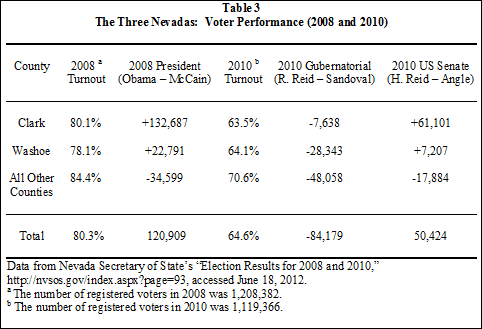For most of the 2012 general election races in Nevada the campaign began in earnest with the conclusion of the state’s primaries on June 14th. However, for the state’s two marquee match-ups – the presidential campaign for Nevada’s six Electoral College votes and the United States Senate contest between Democratic Representative Shelley Berkley (NV-1) and appointed Republican Senator Dean Heller – the campaign has been under way for months.
Indeed, given the levels of attention and resources that these two campaigns are commanding, Nevada’s House races and state legislative races are likely to struggle for oxygen in the fall. To this end, President Obama recently made his tenth visit to the Silver State since his inauguration and First Lady Michelle Obama returned two weeks later for her third 2012 visit. For his part, Mitt Romney recently held a headline making fundraiser in Las Vegas hosted by Donald Trump that netted his campaign around $3 million and the pro-Romney Super PAC, Restore Our Future, received a $10 million contribution from casino mogul, Sheldon Adelson. All four campaigns have also made substantial ad buys in northern and southern Nevada.
The expected competitiveness of these races, coupled with the state’s small size, relatively inexpensive advertising costs, and concentrated populations, has made the state an early target for outside groups as well. Most notably, Crossroads GPS and Americans for Prosperity have used large ad buys to attack Obama and Berkley and more recently, the Harry Reid front-group, Patriot Majority, has taken to the airwaves to soften up Dean Heller. In total, the New York Times reported that Nevada has seen some of the most significant spending thus far in the 2012 cycle including over 6,000 ads in the Las Vegas market since mid-April.
Yet, despite the saturation of the airwaves by the campaigns and attendant outside groups, the two parties’ fortunes will be determined by their field operations. And here the Democrats hold the advantage. The Obama campaign presently has 12 field offices in Nevada. In addition, the Nevada Democratic Party (aka “The Reid Machine”) remains formidable and many of those who worked on Reid’s 2010 successful reelection campaign have gravitated to the Berkley effort (prompting Dean Heller to complain that “I have two opponents, Senator Reid and Shelley Berkley”).
The major headwinds for the Democrats in Nevada remain the state’s dismal economic situation. While there have been signs of improvement throughout 2012, unemployment remains above 11% and the housing and foreclosure meltdown continue to be a drag on the state’s recovery. As a consequence, Nevada Democrats are struggling to recreate the enthusiasm from 2008 when the party was able to expand the size of the electorate from just over one million in 2006 to 1.2 million voters largely because of a 100,000 Democratic voter registration advantage. Since then the registration rolls in the state have shrunk by 13% and the Democratic registration advantage has been reduced to less than 40,000 (see Table 2).
The ability of Republicans to take advantage of Nevada’s economic malaise rest squarely on the party’s ability to develop, fund, and implement an effective ground game literally from scratch as the Romney campaign opted to create a shadow party structure instead of partnering with the dysfunctional Nevada Republican Party. The decision to bypass the state party was driven by a number of factors not the least of which was the recent takeovers of the Clark County and Nevada Republican Party organizations by Ron Paul supporters. After gaining power, those who had even a whiff of establishment to them were purged from party leadership positions and replaced by people who up until late May thought that a bartered GOP convention in Tampa was likely and who have no qualms about openly mocking Romney via an unflattering billboard across from party offices.
To be sure, the Nevada Republican Party has been in a perpetual slide for nearly a decade now and the latest imbroglio adds to Romney’s Nevada burden. Just how effective “Team Nevada” will be in the fall will go a long way to determining if Obama wins in Nevada and perhaps, nationally and if Reid, by virtue of a Berkley victory, remains the Senate Majority Leader.
At the same time, how the presidential and Senate campaigns approach their field operations is complicated by the fact that demographically and politically there is not one Nevada, but arguably three. Specifically, as the data in Tables 1 and 2 summarize, there are sharp demographic and political differences among the state’s population centers in the northern (Washoe County) and southern (Clark County) ends of the state and Nevada’s rural counties.
Most obviously, despite its tremendous land area, Nevada is a highly urbanized state as nearly nine of out ten Nevadans live in Washoe or Clark Counties and slightly less than three-quarters of all Nevadans reside in Clark County. Demographically, Clark County is now majority-minority with Latinos constituting nearly 30% of the county’s population. In contrast, while Washoe County and rural Nevada have growing Latino populations, both remain overwhelmingly white.
These demographic differences correspond with significant political differences. Specifically, as the data in Table 2 indicates, Clark County is strongly Democratic as the county has 75,000 more Democrats than Republicans.[1] In contrast, the rural counties are the Republican stronghold in the state and because of demographic change and investments by Nevada Democrats during prior cycles, Washoe County has emerged as the key swing county within Nevada with Republicans holding a slight registration (less than 4,000) advantage.
Two additional points from Tables 1 and 2 merit discussion. First, while only 58% of age eligible Nevadans are registered to vote, both Washoe County and the rural counties have registration rates that exceed their population shares, while registration in Clark County lags seven points behind its share of the population. Some, but not all of this difference, stems from the larger share of residents under the age of 18 in Clark as compared to Washoe and the rural counties. Second, because better than one in five Nevadans is registered as either a nonpartisan or with a minor party, the hopes of both Democratic and Republicans rest in their ability to attract these voters.
Tables 1 and 2 then paint a picture of a state with three distinct electorates that collectively make Nevada winnable for either party. And while it is cliché to suggest that the party that runs the best campaigns will win, the data presented in Table 3 demonstrate just how true this is in Nevada. Specifically, these data summarize the vote differences in the three Nevada’s for the 2008 presidential election and the 2010 US Senate and gubernatorial races.
In 2008, McCain invested little to no resources in Nevada, while Obama did just the opposite. With little competition, Obama routed McCain in the two population centers and the rural vote was a non-factor. The two races featured from 2010, however, tell a story of a more fickle electorate. Running against Harry Reid’s son Rory, Republican Brian Sandoval not only won Washoe and the rural counties, but was the rare statewide Republican candidate from northern Nevada to win Clark County. At the same time, Harry Reid bested Sharron Angle in Clark and Washoe (her home county) and cut the rural deficit. In total, a remarkable 19% of voters in 2010 split their ballot between the gubernatorial and US Senate contests.
Heading into the fall of 2012, Democrats will focus their efforts almost exclusively on the state’s two population centers (combined, Clark and Washoe Counties contain over 90% of all registered Democrats in Nevada). In so doing, the Democrats will be able to accrue a potentially insurmountable advantage in the south, while either winning outright or keeping the margin close in Washoe. If the Democrats’ game plan holds, then Obama and Berkley will win regardless of what happens in the rural counties.
For Republicans the state’s geography is more complicated. On the one hand, the GOP will be able to shave off some of the Democratic advantage in southern Nevada thanks to the higher registration and turnout rates in the rural counties (see Table 3). However, the inability of the GOP to count on Washoe means that Republicans will need to redouble their efforts in the north as it nearly impossible for a Republican to win a competitive statewide race in Nevada without taking Washoe County. In southern Nevada, Republicans are likely to focus their energy on winning the nonpartisan vote and cutting into Obama’s advantage with the southern Nevada Latino community. To date, Republican engagement with Nevada Latinos have been uneven and seems designed more to peel-off sub-groups, such as the business community and social conservatives, as opposed to engaging the Latino community in any meaningful manner. In a future post, I will analyze in detail how the Democrats and Republicans are seeking to win the support of Nevada’s Latino voters.
[1] Note that given Clark’s immense size, the county also is home to the largest concentration of Republicans in Nevada.
David F. Damore is an Associate Professor of Political Science at the University of Nevada, Las Vegas and an expert in Nevada politics.
The commentary of this article reflects the views of the author and do not necessarily reflect the views of Latino Decisions. Latino Decisions and Pacific Market Research, LLC make no representations about the accuracy of the content of the article.




